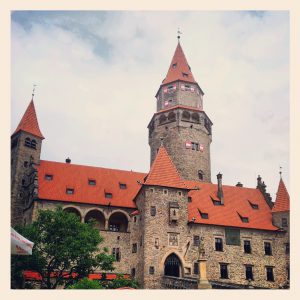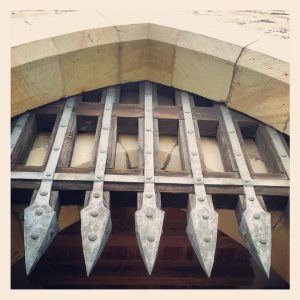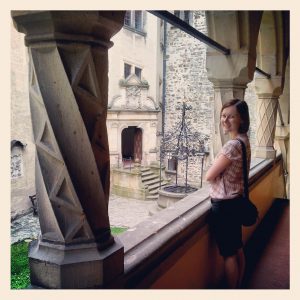Bouzov Castle: A fairy tale come true
By Tracy A. Burns
History of the castle
 Located an hour from Olomouc in central Moravia, Bouzov Castle has a fairy-tale appearance and is without a doubt one of the most impressive castles in the country. Originally built in the early 13th century as a late Gothic stronghold, Bouzov was the property of the Order of the Teutonic Knights from the late 17th century until the end of World War I. (Founded at the end of the 12th century by a group of German merchants, the Teutonic Knights first came to Bohemia in 1203.) The castle looks as it did at the end of its reconstruction at the turn of the 20th century, when Teutonic Knights’ Grand Master Eugene Habsburg, inspired by late Gothic and early Renaissance architecture in Germany and the Netherlands, had what was at the time practically a ruin remade into a residence with a romantic flair. In 1939 the Nazis confiscated the castle, and after World War II Bouzov was nationalized.
Located an hour from Olomouc in central Moravia, Bouzov Castle has a fairy-tale appearance and is without a doubt one of the most impressive castles in the country. Originally built in the early 13th century as a late Gothic stronghold, Bouzov was the property of the Order of the Teutonic Knights from the late 17th century until the end of World War I. (Founded at the end of the 12th century by a group of German merchants, the Teutonic Knights first came to Bohemia in 1203.) The castle looks as it did at the end of its reconstruction at the turn of the 20th century, when Teutonic Knights’ Grand Master Eugene Habsburg, inspired by late Gothic and early Renaissance architecture in Germany and the Netherlands, had what was at the time practically a ruin remade into a residence with a romantic flair. In 1939 the Nazis confiscated the castle, and after World War II Bouzov was nationalized.
 Symbols of the Teutonic Knights
Symbols of the Teutonic Knights
Symbols of the Teutonic Knights’ order figure prominently in the castle; even the order’s crest adorns the second castle gate. Six tombstones of Grand Masters from 1395-1515 can be found in the chapel. In the Knights’ Hall, the coats-of-arms of all the Grand Masters of Bouzov decorate the walls.
Saint George
It doesn’t take long to find a figure of Saint George, one of the order’s symbols. For example, a marble Renaissance statue, hailing from Venice depicts this saint at the chapel’s entrance. An exquisite wall painting of Saint George fighting the dragon adorns the Knights’ Hall.
The representative rooms
The walls of the Hunting Hall depict the ancient tale of Prince Actaeon and Goddess Diana: when Actaeon spotted the goddess naked, Diana got revenge by changing him into a deer. The Knights’ Hall also features a Neo-Gothic fireplace, a Renaissance ceiling, exquisite wall paintings, and stained glass pictures in the windows. The ravishing Baroque Grand Master’s Bedroom boasts exquisitely woodcut sculptural carvings on two closets and chairs, a copy of Rembrandt’s self-portrait, and a tiled stove decorated with figures of men and women clothed in Renaissance attire.
Other intriguing features of the castle
The grating and hatch on the floor of Court Hall lead to the dungeon. Convicts were dropped from this hatch into the prison. The graphics collection in Eugene Habsburg’s private apartments is impressive as are the Nuremberg chandeliers that combine antlers with wooden, human figures. The biggest one weighs more than 300 kilograms (660 pounds) and holds 48 candles.
 The chapel, the armory, and more
The chapel, the armory, and more
In the chapel, a late Gothic altar from 15th century Germany astounds. In the second room of the tour, try to find the secret door and note the colorful tiled stove dating from the beginning of the 12th century. The armory features French horns hanging on a wall, complementing the collection of swords, ancient battered shields, spears, and painted shooting targets of life-size figures. Also of interest are the dragon’s head gargoyles as well as an executioner’s sword dating from 1677 and decorated on both sides. A helical staircase is located inside an octagonal tower. There is, even more, to see: a sundial on the courtyard façade, Gothic lattice windows, arcaded loggia, bear skin rugs made from the last bears to live in the castle’s moat, and the 1929 signature of Tomas Garrigue Masaryk, the first president of democratic Czechoslovakia, in the visitors’ book.
Tour information
There are four tours to choose from. Take a look at the representative rooms for 40 to 50 minutes, or learn about the technical features and fortification elements of the castle for 30 to 40 minutes. There are also possibilities to go up the tower and to visit the cellar spaces. Theatrical performances featuring medieval-dressed characters and sword-fighting also entertain visitors.



